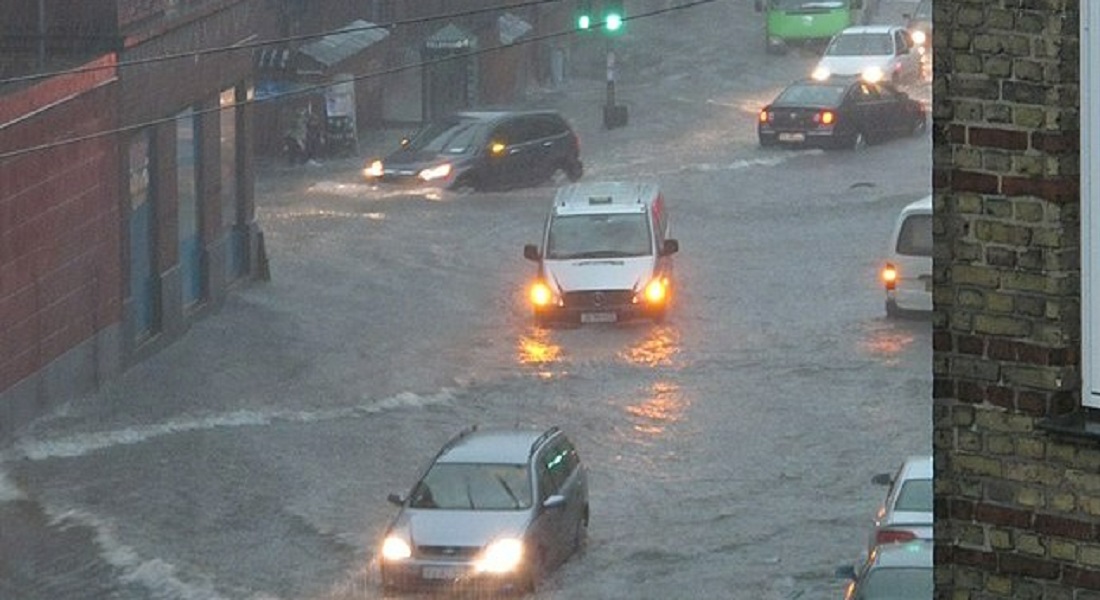Global warming doubled the risk for Copenhagen’s historic 2011 cloudburst
Researchers at the University of Copenhagen, in collaboration with the Danish Meteorological Institute (DMI), have used detailed weather models to clearly tie increased temperatures to the historic cloudburst over Copenhagen in July of 2011. New method involving counterfactual weather forecasts could link the weather event to global warming for the first time.

It is seven o'clock in the evening on July 2nd, 2011. A cloudburst of historic proportions has just struck north of Copenhagen. On the roof of his car, a taxi driver tries to save himself from the floodwaters as rain and hail plunge into the water and cars floating around him on Lyngbyvej.
On this day, the Danish capital experienced an extreme cloudburst that cost society billions of kroner. At Rigshospitalet, the situation was so dire that the floodwater was centimetres away from destroying the hospital's generators and triggering an evacuation of 1400 patients.
Now, Niels Bohr Institute and DMI researchers have used an unconventional tool to understand 2011’s extreme downpour. Counterfactual history is when you change something about an historical event to analyze the What if? Typically used by historians to understand our past, climate scientists have begun deploying the method in a similar way.

Their experiment demonstrates a clear correlation between the intensity of the cloudburst at the time and the heat in the atmosphere leading up to its occurrence.
"Yes, to put it simply you could say that on a planet one degree warmer, a similar weather situation would have likely prompted the evacuation of Rigshospitalet," says Professor Jens Hesselbjerg Christensen of the Niels Bohr Institute.
The cloudburst on 2 July 2011, Copenhagen
The most expensive natural catastrophe in Denmark since 1999. Insurance payments amounted to DKK 6.2 billion, divided into approx. 90,000 claims.
In some places, two months worth of precipitation fell in a few hours. In a single day, 135.4 mm fell at Copenhagen’s Botanical Garden. 31 mm fell within ten minutes in the suburb of Ishøj. More than 5,000 lightning strikes were recorded in 3 hours.
The heavy rain and hail caused traffic to come to a standstill in several places in the metropolitan area as roadways became rivers. Several highways were closed for 1-3 days.
Train traffic was disrupted for a week and in some places closed for days, due to everything from flooded stations to lightning strikes on equipment and landslides.
Approximately 10,000 households suffered power outages for up to 12 hours and approximately 50,000 homes lost heating and hot water for up to a week.
Based on historical weather data
By running different weather simulations for the day of the cloudburst based on DMI models, the researchers produced a number of counterfactual weather forecasts. These were divided into five different heat scenarios, each of which allowed the study to show the consequences of atmospheric temperature increases.
For the first time, the researchers were able to show that a century of human-caused increases in temperature doubled the risk of the historic cloudburst and increased its intensity.
The study also demonstrates that with increasing temperatures ahead of us, there will also be an increased risk of similar or even stronger cloudbursts whenever similar weather situations arise in the future.
The model calculations are based on historical weather data and are thereby supported by empirical evidence.
A difficult linkage
Model calculations of Denmark’s future climate, available in DMI's Climate Atlas, clearly show the connection between warming and an increased risk of cloudbursts. But generally, linking specific weather events to climate change remains a scientific challenge.
What is a cloudburst?
In Denmark, cloudbursts are defined as episodes when more than 15 mm of precipitation falls within a half hour.
Convection is the physical process that causes cloudbursts. Among other things, convection is when lower density, warm air rises.
Warm air, which can be very humid, also draws existing moisture from clouds up to higher altitudes, which creates extreme condensation in the high clouds.
The droplets eventually grow so large that they cannot be held up by the vertical air currents, at which point the clouds suddenly empty their moisture.
In the wake of the July 2011 floods, DMI climate scientist Ole Bøssing Christensen explained that the event could not be directly linked to climate change, but that it did align with climate model predictions for the future.
"That was the type of answer we could give a few years back. We simply did not have the tools to say more. This is precisely the challenge that this study sought to address," explains Jens Hesselbjerg Christensen.
According to Rasmus Anker Pedersen, Head of Section at DMI’s Centre for Climate Research, and co-author of the study, the task succeeded.
"The unique aspect of this study is that we can assess the influence of increased global warming on a specific extreme weather event, as opposed to simply comparing the cloudburst with general changes in a warmer climate," he says.
The grid of data points in climate models is not dense enough to work with weather phenomena like cloudbursts, which occur very locally and are the result of a complex set of convergent weather conditions. However, unlike traditional climate models, DMI's weather models are geared to process weather data on a dense and detailed enough scale.
How the researchers did it
Provides new precision for climate predictions
"If you can operate on the scales that we have been able to here, you capture the processes needed to be able to recreate a specific event in a simulation. It also gives credibility to being able to predict events that have yet to take place," says Jens Hesselbjerg Christensen.
He expects that it will have greater meaning for both everyday citizens and decision-makers when the consequences of climate change become concrete, because they will be able to be linked to known events, such as the 2011 cloudburst. However, the method and use of weather models for climate research also offer perspectives on a global scale.
"While not quite there yet, we expect that there will be enough computing power over the course of the next decade to deploy this type of model on a global scale. This will allow for a whole new level of precision in our climate forecasts. While it will require a lot of processing power, doing so will be relevant. For example, it will help us qualify the preparations needed for climate change adaptation," says Jens Hesselbjerg Christensen.
Contact
Jens Hesselbjerg Christensen
Professor
Ice, Climate and Geophysics
Niels Bohr Institute
University of Copenhagen
Mail: Hessselbjerg@nbi.ku.dk
Tel. + 45 35 33 56 58
Kristian Bjørn-Hansen
Journalist
The Faculty of Science
University of Copenhagen
Email: klu@science.ku.dk
Tel.: +45 93 51 60 02
